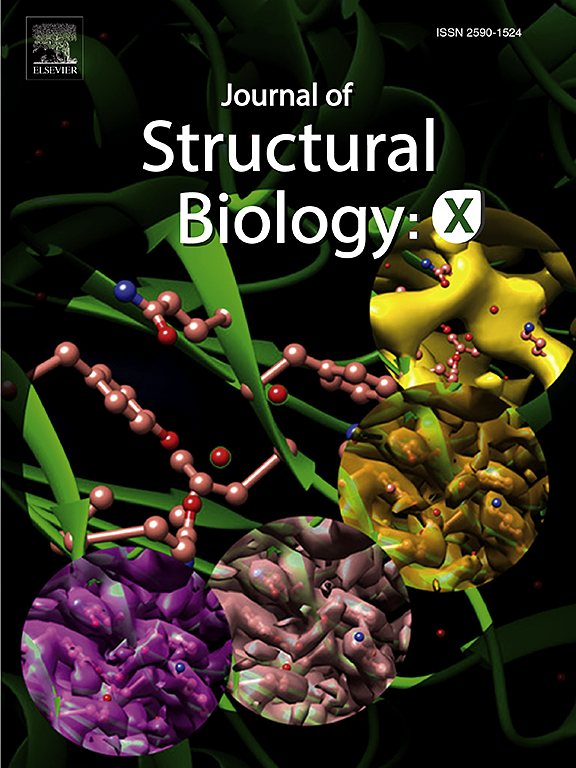利用实验设计优化高效低温电子显微镜网格的战略方法。
IF 3
3区 生物学
Q3 BIOCHEMISTRY & MOLECULAR BIOLOGY
引用次数: 0
摘要
近年来,由于检测、自动化和数据处理等方面的进步,冷冻电镜(cryo-EM)已成为一种实用而有效的方法,能以以前无法达到的分辨率确定结构。然而,样品制备仍然是冷冻电镜工作流程中的一大瓶颈。即使经过艰苦的生化样品优化过程,也往往需要多次反复的网格玻璃化和筛选,才能确定最佳的网格冷冻参数,为数据采集提供合适的冰厚度和颗粒分布。由于高质量的样品是高分辨率结构测定的必要条件,因此网格优化是至关重要的一步。对于依赖低温电子显微镜设备进行网格筛选的研究人员来说,每次优化过程的反复都可能会延误几个月的研究进展。因此,应采取更具战略性和更高效的方法,确保在尽可能少的迭代中完成网格优化过程。在此,我们介绍一种实验设计(DOE)的实施方法,以加快网格优化过程并使之战略化。分数因子设计(FFD)指导确定一组有限的实验条件,这些条件可以模拟感兴趣的全部参数空间。根据这些条件冻结网格,并筛选颗粒分布和冰层厚度。根据定性评分标准对每个网格特征进行定量评分。输入条件和响应分数用于在 JMP 中生成参数空间的最小二乘回归模型,该模型用于确定理论上应产生最佳网格的条件。在 Vitrobot Mark IV 和 Leica GP2 柱入式冷冻机上对阿朴铁蛋白和 L-谷氨酸脱氢酶进行测试后,得出的网格条件可靠地生成了具有高质量冰和颗粒分布的网格,适合在 Krios 上收集大型过夜数据集。我们的结论是,基于 DOE 的方法是一种经济高效、节省时间的低温电子显微镜网格制备工具。本文章由计算机程序翻译,如有差异,请以英文原文为准。

A strategic approach for efficient cryo-EM grid optimization using design of experiments
In recent years, cryo-electron microscopy (cryo-EM) has become a practical and effective method of determining structures at previously unattainable resolutions due to advances in detection, automation, and data processing. However, sample preparation remains a major bottleneck in the cryo-EM workflow. Even after the arduous process of biochemical sample optimization, it often takes several iterations of grid vitrification and screening to determine the optimal grid freezing parameters that yield suitable ice thickness and particle distribution for data collection. Since a high-quality sample is imperative for high-resolution structure determination, grid optimization is a vital step. For researchers who rely on cryo-EM facilities for grid screening, each iteration of this optimization process may delay research progress by a matter of months. Therefore, a more strategic and efficient approach should be taken to ensure that the grid optimization process can be completed in as few iterations as possible. Here, we present an implementation of Design of Experiments (DOE) to expedite and strategize the grid optimization process. A Fractional Factorial Design (FFD) guides the determination of a limited set of experimental conditions which can model the full parameter space of interest. Grids are frozen with these conditions and screened for particle distribution and ice thickness. Quantitative scores are assigned to each of these grid characteristics based on a qualitative rubric. Input conditions and response scores are used to generate a least-squares regression model of the parameter space in JMP, which is used to determine the conditions which should, in theory, yield optimal grids. Upon testing this approach on apoferritin and L-glutamate dehydrogenase on both the Vitrobot Mark IV and the Leica GP2 plunge freezers, the resulting grid conditions reliably yielded grids with high-quality ice and particle distribution that were suitable for collecting large overnight datasets on a Krios. We conclude that a DOE-based approach is a cost-effective and time-saving tool for cryo-EM grid preparation.
求助全文
通过发布文献求助,成功后即可免费获取论文全文。
去求助
来源期刊

Journal of structural biology
生物-生化与分子生物学
CiteScore
6.30
自引率
3.30%
发文量
88
审稿时长
65 days
期刊介绍:
Journal of Structural Biology (JSB) has an open access mirror journal, the Journal of Structural Biology: X (JSBX), sharing the same aims and scope, editorial team, submission system and rigorous peer review. Since both journals share the same editorial system, you may submit your manuscript via either journal homepage. You will be prompted during submission (and revision) to choose in which to publish your article. The editors and reviewers are not aware of the choice you made until the article has been published online. JSB and JSBX publish papers dealing with the structural analysis of living material at every level of organization by all methods that lead to an understanding of biological function in terms of molecular and supermolecular structure.
Techniques covered include:
• Light microscopy including confocal microscopy
• All types of electron microscopy
• X-ray diffraction
• Nuclear magnetic resonance
• Scanning force microscopy, scanning probe microscopy, and tunneling microscopy
• Digital image processing
• Computational insights into structure
 求助内容:
求助内容: 应助结果提醒方式:
应助结果提醒方式:


